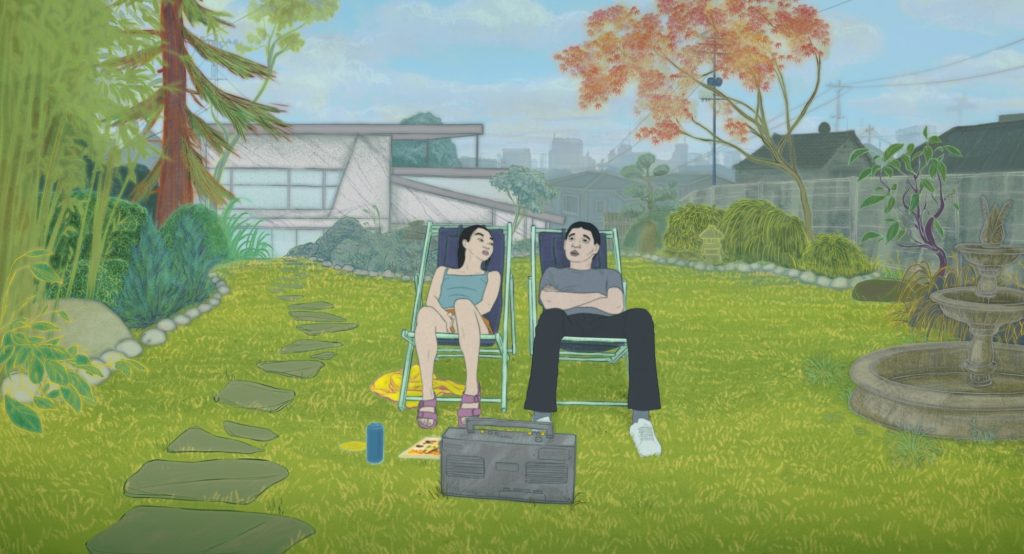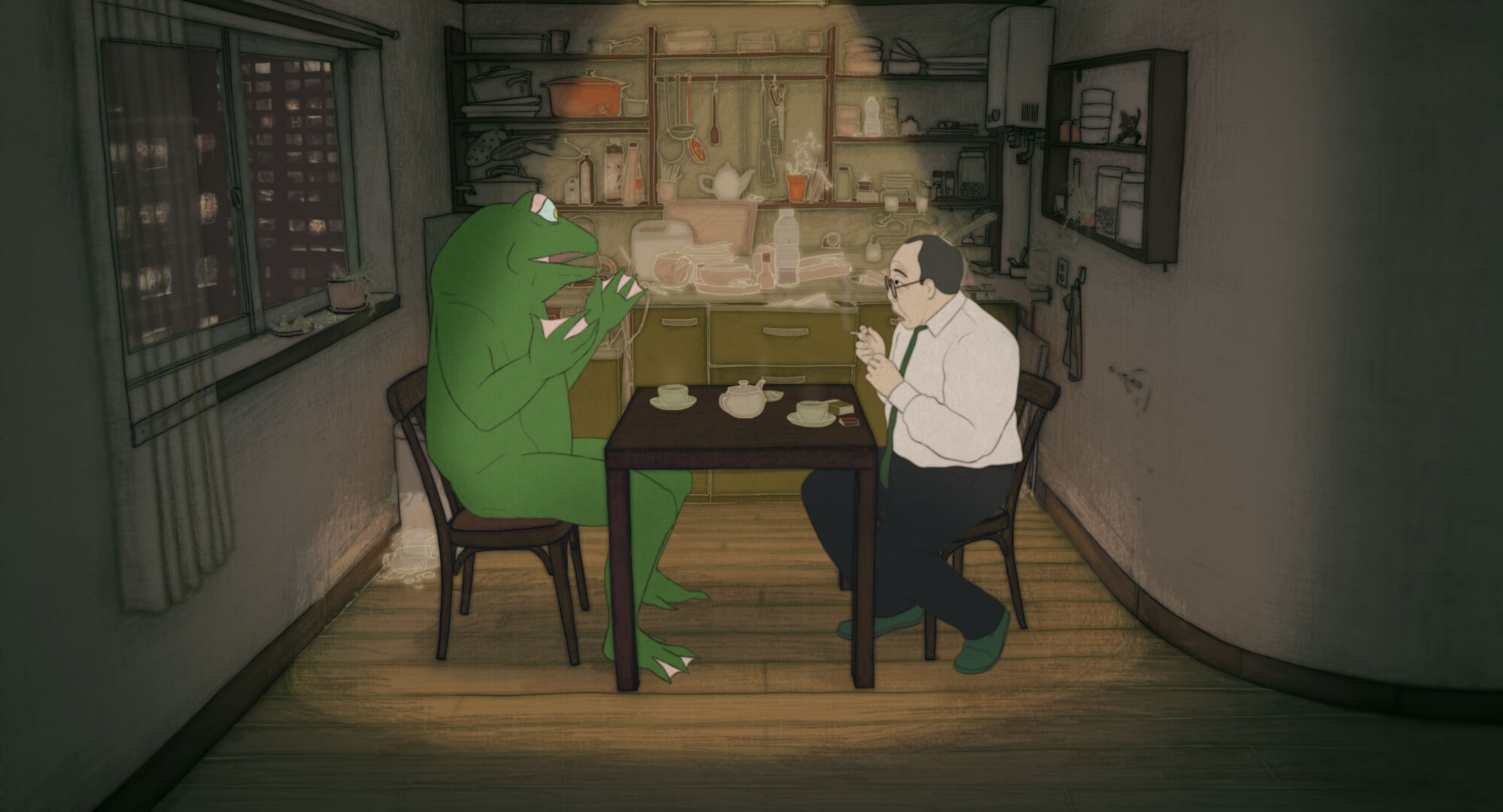Blind Willow, Sleeping Woman: A Meditation on Murakami

Surreal, melancholic, dreamlike, and eternally meditative are words that most closely, but not entirely, describe Pierre Földes’ debut feature animation film, Blind Willow, Sleeping Woman. Inspired by Haruki Murakami’s short stories, the film explores the consequences of trauma and the creativity of the human mind in overcoming it. A talking frog, a giant earthworm, an earthquake, a tsunami, a birthday wish, and a cat are all simply words on a page, but they become standalone characters as the audience is submerged into Földes’ film. It encourages us to look beyond what we see, and that the line between reality and imagination must be blurred in order to become our true selves. The untying of desires and fantasies dominate the main characters’ transformation, that inevitably resonate with those who have ever questioned the direction of their lives.
FRONTRUNNER sat down with Földes to discuss daydreams becoming dreams (and vice-versa), the symbolic creatures existing between mythology and intelligent metaphor, the power and (oftentimes) false reality of our thoughts, and how trauma may save us from ourselves, and everyone else, in the long run.

Blind Willow, Sleeping Woman is a Haruki Murakami adaptation, but I think your film becomes much more than that. It’s animation for a mature audience with endless metaphors. It reinvents the genres of surrealism, magical realism, and sci-fi. What does the film mean to you, and where would you place it in the cinematic world?
I’m happy is someone does – I’m perhaps not the one to place it anywhere. I’m conscious that it’s a film that’s unusual in several ways. It’s not a film where the plot goes from A to B, and there are three parts and an epilogue. I aimed to innovate with a new approach to storytelling and filmmaking.
Symbolism is a key element. We could talk about many symbols in the film such as the talking frog, the giant worm, the tsunami, etc., But, let’s start with the worm. Myths say that earthworms symbolise death and renewal, or negativity, self-doubt and feeling invisible. In your film, it’s an illusion, but can you talk about the significance to you and the character?
I don’t exactly function that way. I interpret things in a way that I immerse in my time and the Western society I live in. When I create my story and film, I’m not thinking of what things will represent. I take many elements from the work and stories I’m inspired by. I build from what comes to my mind and follow that through to the end. Personally, the giant worm is nothing more than a metaphor for one of the characters built as an entity that’s neither bad nor good but something that’s going to turn things upside down. The same way as the taking frog is created from the accountant’s alter ego. He created the frog who’s the good magician, and the worm who’s not evil, but the guy who comes and moves things around. By combining all this, he changes his world.
It often seemed that the frog was a metaphor for being chased by one’s demons.
It’s true that some people from different cultures, for example, the Japanese like to think of the creature as symbolism. I believe a frog in Japanese culture is a symbol of change. As I said, I function more instinctively; I have images that come to my mind, and I follow them because I am attracted to those images.
Isn’t it rewarding if everyone takes away something completely different because that’s how you can encourage audiences to talk about your film?
I want people to be inspired. I want to open windows in their minds.

Blind Willow, Sleeping Woman (2022)
Dir. Pierre Földes
Image courtesy of Cinéma Defacto, Miyu Productions, Doghouse Films, micro_scope, Productions l’unité centrale, An Original Picture, Studio Ma
Dreams are truly fascinating, despite us all having them. Dreams appear either nightly, in one’s sleep, or in the day, while dreaming of better things. The two types of dreams cross over, which creates this sense of surrealism. Do you have a fascination with dreams, or pay particular attention to them?
It’s not just dreams. I think because I’m an artist, my perception is as such. A bit like I was on drugs all the time, which I am not. I try to transpose and illustrate my perception in film, which led to an attraction to create something in animation. I don’t think live-action would have been impossible. It’s not. Someone like David Lynch manages to create a surreal atmosphere in live-action, even though he uses lots of special effects. In animation, you can create your image and define everything in that frame, therefore constructing a different dimension. It’s not just the flat reality you are showing. You can decide if something will be blurry or a certain colour through which you can define your reality. You are right because there are dream sequences, but there are also daydream sequences. From the beginning, I absolutely wanted to blur the lines between the two. I like the idea of being in somebody’s mind who is seeing and imagining something because that’s the way many of us are. You might be talking to someone, and simultaneously you have other thoughts passing by. This perception of the person talking to you becomes a little bit different. I find that fascinating.
Many people find it taboo to discuss loneliness. They feel ashamed of being alone. A perfect example is Mr. Katagiri, the accountant. He shares his vulnerability of being an ordinary man, 44 years old, going bald, with diabetes, and has no sex. What creative tools did you use to make this emotion register on the screen? Loneliness is such a quiet thing, but it’s very loud on the screen.
Before making the film, I made a few short films. I was a composer. The subject of these short films was exactly that. Urban loneliness. Similarly to this Murakami adaptation, I’ve always been interested in this ordinary urban loneliness in which the characters are allowed or even forced to find their own world. Something they can cling to in this entangled crazy dream. Life in this place and city with everything that’s going on is impossible. You must have a connection with something almost magical to be able to keep going.
“True terror is the kind men feel towards their imagination,” is a phrase from the film that is so accurate, as imagination is probably the most terrifying thing about us humans. That’s what makes us question our sanity. From your point of view, what would you say are the advantages and disadvantages of the power of imagination, even in the film or as a filmmaker?
What I think that line is pointing out is the representation of fear that triggers terror in someone. It’s powerful. If somebody in the street is coming towards you with a knife, that’s terrifying, but I would also say, what’s happening in your head, and how you see the situation is the actual terror. Also, it’s your visions that chase you in your head when you are daydreaming, or you are awake at night, and you start thinking of many things. That can truly be horrible but also wonderful.
The film shows what it’s like to reconnect with yourself again. Interestingly, you’re reconnecting your characters with reality through memories, fantasies, and dreams in the film. How do you think your characters evolved through trying to reconnect in these weird and wonderful ways?
The film is about characters living through a traumatic event that triggers them to have a “wake up” moment. I think most characters in films try to look for their reality and truth. So, the characters in my film are trapped in a life they are not living. And these traumatic events triggered this awakening. They wake up, open their eyes and recognise the truths they were hiding from themselves. In the main female character, Kyoko’s case, the earthquake triggers one of her frustrations, which is that she’s married to a gentle and loving guy, but somehow it’s not what she was hoping for. She wished for something else. For her husband, Komura it’s the fact that she leaves him, which is the traumatic event. She tells him you’re nice, but “living with you is like living with a chunk of air”. He is stuck with this horrible anxiety thinking, ‘Am I empty?’, ‘what does it mean to be empty?’, and then little by little, the dramatic letters she leaves him is going to help him realise and find a way to get rid of his emptiness. This also applies to the other character, Katagiri. He is frustrated, bald, has no sex life, and everybody takes advantage of him. He experiences the earthquake and imagines that if he was a superhero, he could find something in his life therefore see himself from a better angle. Then comes the talking frog who gives him this opportunity.

Blind Willow, Sleeping Woman (2022)
Dir. Pierre Földes
Image courtesy of Cinéma Defacto, Miyu Productions, Doghouse Films, micro_scope, Productions l’unité centrale, An Original Picture, Studio Ma
“Living with you is like, living with a chunk of air”, is probably the saddest criticism one could get. At some point in the film, it feels as if the audience becomes the psychiatrist or the therapist watching someone grow and overcome their trauma. That leads to letting go of something, which people always find difficult. All of your main characters need to let go of a chapter in their lives. So, circling back to the worm and the frog, your characters had this guidance through magical realism. Is there a message you wish to send to the audience when it comes to letting go?
Not necessarily, but as I said, I work from inspiration. I am inspired by the world that I’m living in. I look at all these characters around me, and try to inspire them through these stories, not just to let go, but to let go of what they’re not and open their eyes to truly who they are. You must be willing to dive in and not cling to your little miserable self. Yes, you must learn to let go and be open to embrace something else. I loved working on every part of this film, from adapting the stories, working with actors, then transposing it with animation, and finally finding the music. I’m very proud of my collaboration, starting with Mr. Murakami, and I hope Blind Willow, Sleeping Woman will open possibilities for further experiments and adventure. I am looking forward to discovering what I have learned in tackling the next challenge.









Responses